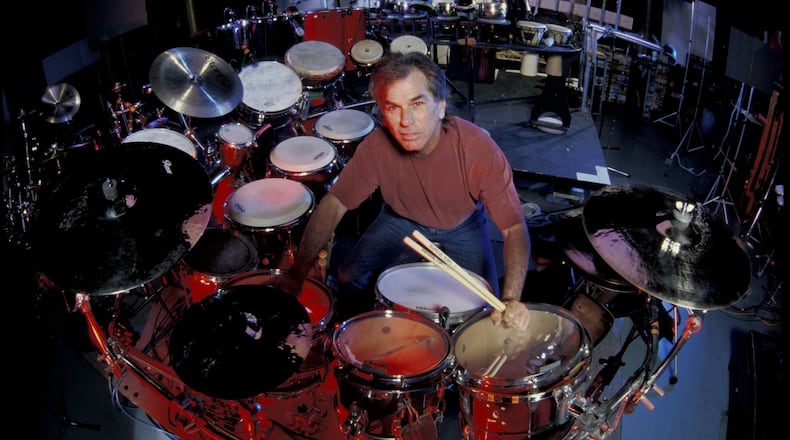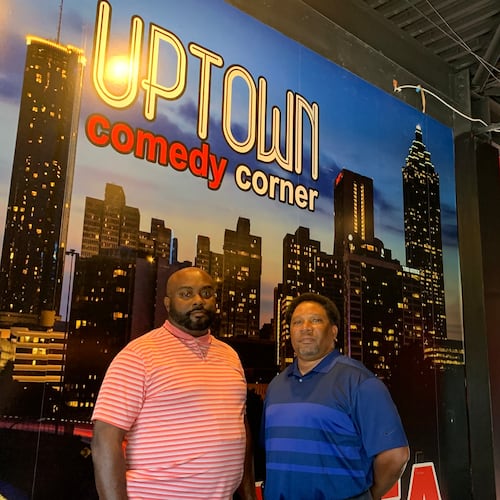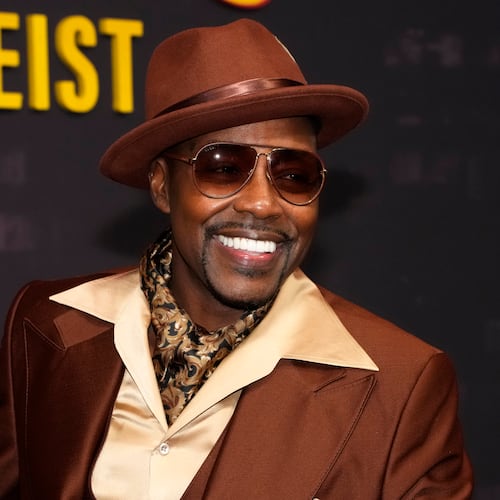Grateful Dead fans revere Mickey Hart for his intense, free-flowing drumming style.
The longtime percussion wizard – who is also an author, artist and musicologist – has perched behind an array of drums, bells, congas, gongs, cymbals and woodblocks since the late ‘60s, and remains in the current incarnation of the psychedelic folk-rock icons – Dead and Company.
Hart, 75, is also rooted in his spiritualism – the kind of artist for whom music and art not only intersect but instead reside in his soul. And he’s happy to expound on those abstract feelings.
Dead and Company return to Atlanta on June 29 for a concert at Cellairis Amphitheatre at Lakewood. But this weekend, Hart will debut his artwork at Wentworth Gallery at Phipps Plaza.
The unique musician chatted last week with The Atlanta Journal-Constitution and Kaedy Kiely of The River 97.1 FM about what he calls "Vibrational Expressionism," his memories of composing the music for the for the 1996 opening ceremonies at Atlanta Olympics and why John Mayer is an ideal addition to Dead and Company.
Q: Tell us about your artistic style.
A: If you want to talk about rhythm, that's what these works are all about, as you could assume. They flow, they have beautiful forms – like rivers, mountains, animals – almost anything that your mind can conjure. No two people will see these paintings the same. It's a sonic painting. This is a visual component to what you would see at a Dead show. These are pieces of me – my work, my groove, my rhythm. This is the way the music looks, the way I feel rhythm is continuous motion…and in the process I vibrate (the art) into existence. I use vibration to bring out the colors and details after I pour it, whether it's oil or acrylic.
Q: How did you get the idea to drop the paint from above onto the canvas with the swivel mounts?
A: I had to devise a tool to do this. Her name is Rainbow, and she has the ability to lean into directions and spin and always come back to zero gravity. Once I designed Rainbow, it was a matter of mixing paints and being able to bring the right technique, whether its canvas or wood or Plexiglas. A lot of it is a physiological thing for me. It's a physical thing, moving fast, making decisions rapidly. It's fun, full of wonder and surprise – for me and the people who view it. It's a wonderful counterpart to my sonic world.
Q: Did you ever take painting lessons?
A: I don't know about painting (formally). A long time ago, maybe 15 years ago, it was the "Dance of Death" series by Hans Holbein (that piqued my interest). He was a 16th-century woodcutter who drew this series with these beautiful skeletons and that inspired me because of the Grateful Dead and skeletons – half in the world of the dead, half in the living. (Painting) is definitely a learning process; I'm going into the unknown, and I like to do that with my drumming, and it's fun. This is an edge, and it's not for everybody. I felt secure enough to be able to bring it out to people. It was not meant to be sold; it was my personal hobby. People really love (the art), and that's the only reason I do this. Every time they look at it, they get the feeling, hopefully, that I put into it.
>> Listen to Kaedy Kiely and Melissa Ruggieri's "2 Girls Talking" podcast on iTunes
Q: You composed the music for the opening ceremonies of the 1996 Olympics in Atlanta. What do you remember from that?
A: There were hundreds of drummers on the field; it was the first 10 minutes or so of opening ceremonies. That was a kick! They had all of those drummers on bungee cords smacking drums. There were so many dogs and police there backstage. The whole place had so many secret service agents. (Then-President) Bill Clinton was there. We saw each other right after. It was me and him and Muhammad Ali. We were all hoping for (Ali). We didn’t know if he would even make it, and he was a little shaky, but he wanted to do it. Everybody was holding their breath. He’s a hero to me. Being in a room alone with him, I said, “I love you” and kissed his hand. Clinton came in there and hugged him and cried.
Q: Is that still your music being used at the Mirage’s volcano in Las Vegas?
A: I did that installation in front of the Mirage. It was as close to the real thing as you can get! About 350 speakers embedded, the fires shooting up, the volcano erupting. It was 111 (decibels) down the street. They timed the lights and the water to the drums so they're totally in sync, so whatever unfolds in 15 minutes is totally synced to the percussion score. From time to time I go up there and stand in the crowd and watch it. Sometimes when I'm there, I take the band in the bowels (of the casino) to show them the incredible equipment. It's like rocket science.
Q: You’ve done some research on how music and vibration might help mitigate dementia. Tell us about what you’ve found.
A: We know that dementia is just broken connections to your brain, so how do you fire those neurons again and reconnect? You find that rhythm - specifically low end - works. Science is starting to validate the use of rhythmic stimuli. It reconnects the broken pathways somehow.
Q: Dead and Company tours relentlessly, and you’ll be back here in June. Atlanta seems like a good market for the band.
A: The Grateful Dead had a time in Atlanta (and) Dead and Company is picking it up where they left off. We played Atlanta a lot. It's a great unit. It really lives – it's a living, breathing musical creature. It's different every night because we can't remember how we did (the songs) the night before! As always, we don't have good beginnings and endings. It's kind of charming in its own way.
Q: John Mayer seems to be fitting in well.
A: John is doing great. He's a pleasure to be around. He's very nice, very respectful and knows how to play that guitar. And he's getting better and better at this improvisation business. It's hard when you play specific songs in a certain way, but that's different than Dead and Company. He's not like a hired hand; he's starting to become one with the music. That's a feather in his cap because this ain't easy music! It flows out of us because we are it, but if you break it down for anyone else, that's daunting. I have to give him credit for even attempting it.
ART PREVIEW
Mickey Hart of the Grateful Dead
2-4 p.m. Sunday. Free. Wentworth Gallery, Phipps Plaza, 3500 Peachtree Road, Atlanta. 404-233-0903, wentworthgallery.com
About the Author
Keep Reading
The Latest
Featured





